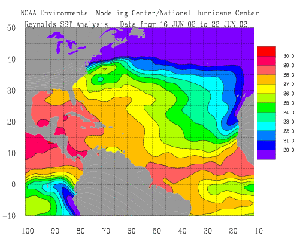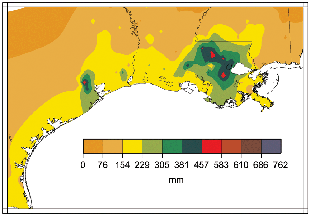Note: This report catalogs recent tropical cyclones across the North Atlantic and East Pacific and places each basin’s tropical cyclone activity in a climate-scale context. It is not updated in real time. Users seeking the real time status and forecasts of tropical cyclones should visit The National Hurricane Center.
 larger image |
Hurricane season in the Atlantic begins on June 1st. The map to the left shows sea-surface temperatures for the Atlantic averaged over the period 16th-22nd of June. In order for tropical waves to develop into tropical storms and hurricanes, sea surface temperatures generally need to be above 26°C (78.8°F). As is evident in the map, the Gulf of Mexico and Caribbean Sea region as well as much of the western tropical Atlantic have warm enough SSTs for hurricane formation to occur. However, other atmospheric conditions have not been favorable for tropical storm development, consequently in June 2002 there was no tropical storm or hurricane activity.
|
| On average only one named system (tropical storm strength or greater) forms in June in the Atlantic basin, so the lack of activity in June is not unusual. In 2001, however, Tropical Storm Allison formed in the Gulf of Mexico on June 5 and became the costliest tropical storm in U.S. history causing around $5 billion in damage. This was principally due to the intense rainfall accompanying the slow-moving storm. Rainfall totals for June 4-10, 2001 for coastal Texas and Louisiana can be seen on the map to the right. |  larger image |
 NOAA's National Centers for Environmental Information
NOAA's National Centers for Environmental Information